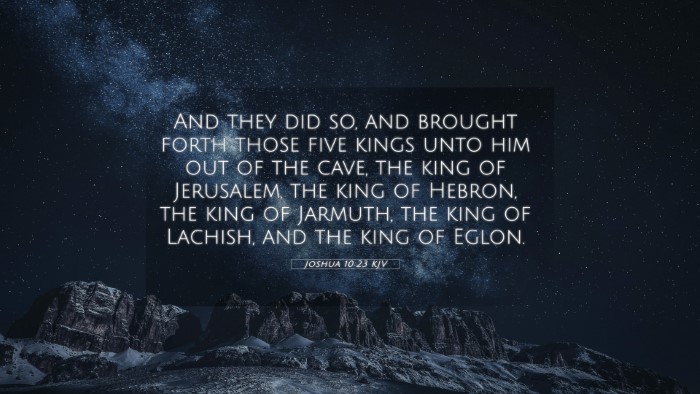Bible Verse Interpretation - Joshua 10:23
Verse: Joshua 10:23 - "And they did so, and brought forth those five kings unto him out of the cave, the king of Jerusalem, the king of Hebron, the king of Jarmuth, the king of Lachish, and the king of Eglon."
Summary of the Verse
This verse relates to a pivotal moment during the Israelite conquest of Canaan, specifically regarding the defeat of the southern kings who opposed their advance. The Israelites captured five kings and placed them before Joshua, demonstrating God's involvement in the battle and the authority of Israel's leadership.
Insights from Public Domain Commentaries
Matthew Henry's Commentary
Matthew Henry emphasizes the significance of the capture of these kings, viewing it as evidence of God's support for Joshua and the Israelites. The act of bringing the kings before Joshua illustrates the totality of their defeat and serves both as a warning to others and a chance for Israel to seek justice against their enemies.
Albert Barnes' Notes on the Bible
Barnes points out that the five kings represent the notable opposition that Israel faced. The act of capturing and executing these kings was not merely for revenge but was part of fulfilling God's promise to Israel in claiming the land. This moment underlines the theme of divine justice and the ultimate victory of God over adversaries.
Adam Clarke's Commentary
Clarke brings attention to the capture methods and the strategic importance of these cities. He explains that the cities had been previously strongholds of opposition against Israel. Delivering these kings into the hands of Joshua signifies the weakening of their power and the establishment of Israel’s dominion over Canaan.
Thematic Connections and Cross-References
Joshua 10:23 is deeply connected with several other biblical passages that fortify its meaning and relevance. Below are notable cross-references:
- Joshua 10:5 - Discusses the confederation of kings against Israel.
- Exodus 15:6 - Highlights God’s ability to triumph over enemies.
- Psalm 68:1 - A reminder that God scatters adversaries as Israel advances.
- Isaiah 54:17 - Promises that no weapon formed against God’s people will prosper.
- Romans 8:31 - Asks if God is for us, who can stand against us?
- Hebrews 11:30-31 - Reflects on the faith of Israel in the fall of Jericho.
- Revelation 19:11-16 - Depicts the ultimate victory of Christ over all enemies.
Understanding the Implications
This verse not only narrates a historical event but serves as a moral and spiritual lesson about the consequences of opposing God’s will. The capture of the kings and their fate relate to the broader biblical theme of judgment against those who stand against God’s people.
Tools for Cross-Referencing
For deeper study, various resources can be utilized to further explore themes and connections within the Bible:
- Bible concordance for quick verse lookup.
- Bible cross-reference guide to find verses linked across books.
- Cross-reference Bible study examples for group discussions.
- How to use Bible cross-references through comprehensive study methods.
- Bible chain references can help illustrate continuous themes across Testaments.
Enhancing Understanding through Cross-References
Engaging with these cross-references allows for a thorough understanding of how different scriptures interact. For instance, examining the similarities between Joshua's leadership and the authority of Jesus in the New Testament provides insights into the progressive revelation of God’s plan for redemption.
Inter-Biblical Dialogue
Through inter-Biblical dialogue, connections can be drawn between the Old and New Testaments. For example, Joshua's role in leading Israel into the Promised Land parallels Christ's leadership in leading believers into eternal life, highlighting the continuity of God’s salvific plan throughout scripture.
Conclusion
Joshua 10:23 serves as an engaging text that reflects God's faithfulness to His people, revealing both historical and theological layers. By utilizing the tools for cross-referencing and understanding connections between Bible verses, readers gain access to a richer tapestry of scriptural truth, inviting deeper study and reflection.





